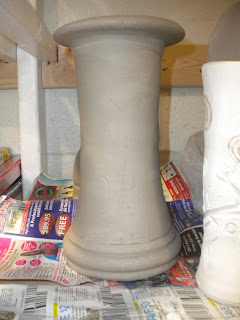I am now on the journey of using terra sigillata to begin the decorating of Nugget and finally Norris, the moon animal will be on the piece. So what exactly is terra sigillata?
Terra Sigillata is what the ancient world used before they had modern day glazes.It is a mixture of dried clay and coloring and water. It comes in mainly white, creme, black, red, and brown. For instance, the Greeks red and black vases are a prime example of this.


There are specific formulas for it, like a recipe for cooking. The one that I made the other day, for instance, had to have 28 pounds of water to 14 pounds of dried ground up, powder form clay. Then after mixing the terra sigillata, we had to let it set. It takes anywhere from 48 hours to 5 days to set the mixture just right. Once it is set there are three distinctive layers in the bucket. The top coat is the water that has pulled to the top, the bottom is left over clay sedatives, and the middle is the good stuff. The middle is the terra sigillata. This is what is used to decorate the pots.
Everything in the ceramics world takes a while to dry. So before I can begin glazing my second piece inspired by Barbra Hepworth it has to dry, which means I am moving on to another piece.
I am now in the process of building a reliquary, but not your ordinary square box with decorations on it. I am making something to hold my Pisces spirit. What better for a Pisces spirit than a coral reef! Clever right? Well I thought so. In order for it to look important and not like a diorama I am morphing it with what will be it’s base. The base will be an ionic column, with curvy flutes. What I am most excited about is the experimentation I will get to do with texture, and once it dries out enough, the bright colored glazes I will get to use! Bright colors make me so happy. Don’t believe me? Take a peek at the bedroom I painted Sunkist orange.

The little curly plants in the picture below is what inspired me for the ionic columns.

While I am working on this Coral Reef Reliquary, I am using recycled clay. Yep, I said recycled clay. I had no idea you could do this, but turns out you can. You take pieces of dried up, hard clay then soak it in water. The water puts the moisture back into it. Then you use a machine called a pug mill.
 This is an example of a pug mill. The tube coming out of the right is the clay!
This is an example of a pug mill. The tube coming out of the right is the clay!
As you are putting the clay into the pug mill you make sure there are no random items in it, like a spoon, or rubber ribs (we found these when we were using the pug mill). The pug mill, with the mixture of grog (pulverized fired clay or even temper), push it out into clay bars, which in turn can be reused for more projects. It is very nice to not have to go to the store to get more clay, but to reuse stuff people didn’t need or want. Talk about being green!










 Tada! 10 cylinders 6 of which are 8 inches and the other 4 are 10 inches!
Tada! 10 cylinders 6 of which are 8 inches and the other 4 are 10 inches! 







































